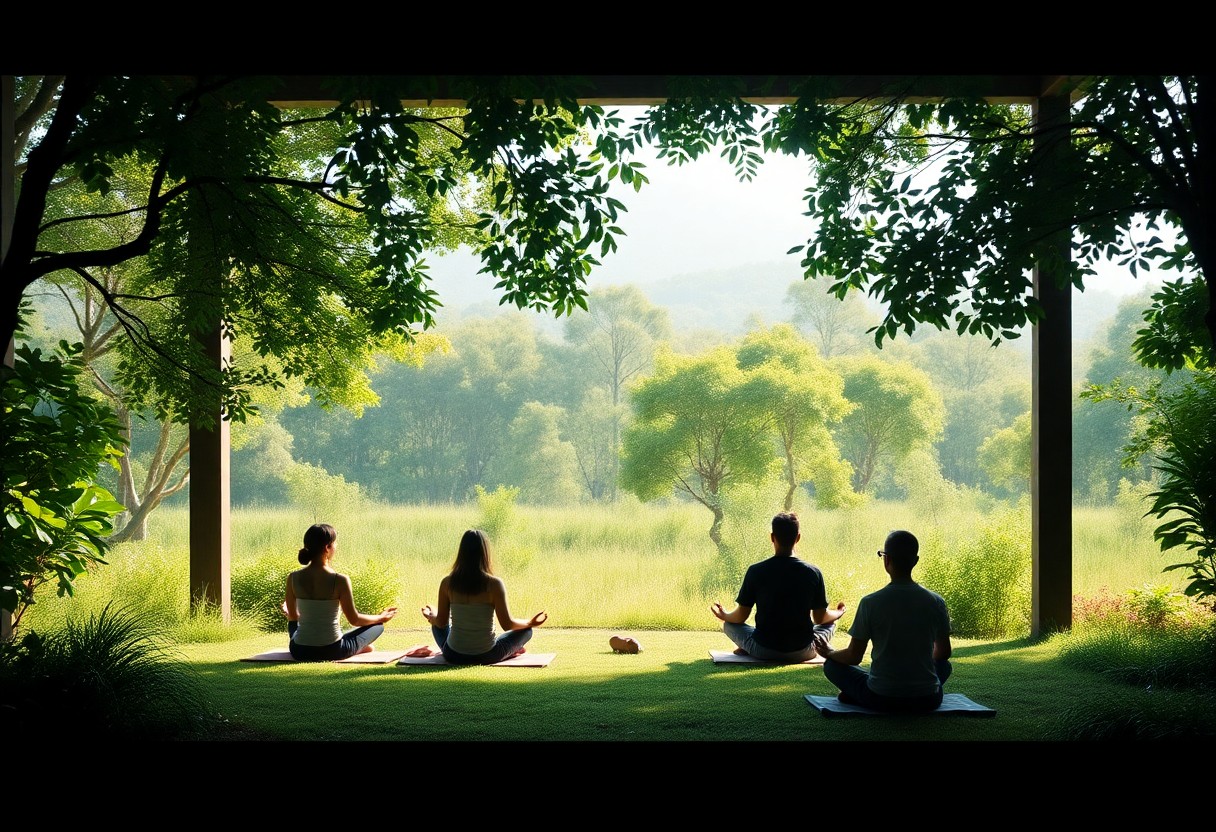Silent meditation retreats offer you a unique opportunity to disconnect from daily noise and distractions, allowing deep introspection and mental clarity. By embracing silence, you can significantly reduce stress and anxiety, enhance your emotional well-being, and cultivate mindfulness with greater focus. These retreats provide a safe space for you to explore your inner world, often leading to profound personal growth and improved resilience. Additionally, the absence of external stimuli helps your mind reset, promoting long-lasting peace and balance in your life.

Cultivating Inner Peace through Silence
The Role of Silence in Mindfulness
Silence acts as a powerful catalyst for deepening your mindfulness practice by removing external distractions and allowing heightened focus on your internal experience. In silent meditation retreats, the absence of verbal communication forces you to turn closer attention toward your mind, body, and breath, facilitating a more profound connection with the present moment. Without the typical noise of daily life, you can observe thoughts and emotions with less judgment and greater clarity, creating space for intentional awareness rather than reactive patterns.
Neurologically, silence has been shown to activate regions of the brain involved in introspection and emotional regulation. Studies using neuroimaging techniques demonstrate increased activity in the prefrontal cortex during silent meditation, which enhances concentration and executive functioning. This shift in brain activity supports the development of mindfulness, as you become more capable of consciously directing your attention and responding thoughtfully to internal and external stimuli. By silencing chatter, you effectively train your mind to stabilize amidst the habitual distractions and mental clutter.
Alongside these internal processes, cultivating silence also deepens your experiential appreciation of sensory phenomena. When external noise is diminished, subtle sounds and bodily sensations become more pronounced, encouraging a more grounded sensory mindfulness. This expanded sensory awareness nurtures a state of calm vigilance where your awareness remains open without becoming overwhelmed, embodying the essence of mindful presence throughout your meditation and beyond.
The Impact of Extended Quietness on Stress Reduction
Prolonged silence during meditation retreats interrupts the overstimulation caused by constant noise pollution and information overload, which can trigger your body’s stress response. With extended quietness, cortisol levels—the hormone associated with stress—have been observed to decrease significantly, according to clinical studies involving retreat participants. This hormonal shift fosters a physiological state of relaxation that aids in resetting the nervous system, reducing chronic tension, and enhancing overall well-being.
Your autonomic nervous system undergoes recalibration in these quiet retreats, with a notable increase in parasympathetic activity responsible for rest and digest functions. At the same time, sympathetic nervous system arousal, often linked to stress and fight-or-flight reactions, diminishes. This biological rebalancing explains why many individuals report feelings of profound calm and emotional detachment from daily anxieties following a few days of sustained silence. The calming effect lasts beyond the retreat period, offering a durable buffer against future stressors.
The mental quiet achieved during extended silent periods contributes to reducing rumination, one of the leading cognitive factors that amplify stress and anxiety. For example, retreat studies show that participants experience lower levels of intrusive repetitive thoughts, which often compound emotional distress. As a result, you gain greater clarity and emotional resilience, better equipped to manage stressors with composed awareness rather than reactive tension.
Apart from the biological and psychological benefits, the social dynamics of silent retreats also lower stress by reducing interpersonal conflicts and the cognitive load of conversation management. This environment fosters a gentler self-awareness where you can observe your habitual stress responses without external triggers, guiding you towards sustainable stress management techniques rooted in mindfulness and acceptance.
Enhancing Mental Clarity and Focus
Silent meditation retreats create an unusual environment where mental noise—the constant chatter and bombardment of external stimuli—is dramatically reduced. In this setting, your brain no longer has to constantly filter out distractions, allowing for a sharpening of your mental faculties. Reports from participants often mention an increased ability to concentrate, sometimes even days after the retreat has ended. This improvement is not just anecdotal; scientific studies reveal that during extended silence and meditation, your brain’s prefrontal cortex—the area responsible for decision-making, attention control, and problem-solving—shows heightened activity and connectivity.
Another reason your mental clarity improves significantly during and after these retreats has to do with the brain resting from overstimulation. Daily life bombards your sensory system with a steady influx of information, which can lead to cognitive fatigue. During a silent retreat, the absence of unnecessary sensory input gives your neural networks time to recover and reorganize. This “reset” effect can sharpen your ability to process information swiftly and accurately. In practical terms, this means you might find yourself better able to focus on tasks, make clearer decisions, or even retain information more effectively.
Emotional tranquility achieved through silence also facilitates improved cognitive function. Anxiety and stress are known to impair working memory and executive function. As you experience sustained calm through silent meditation, the reduction in stress hormones such as cortisol further liberates your cognitive resources. This newfound mental space lets you approach problems from a place of equanimity and clarity, providing a mental edge both during and after the retreat experience.
Neuroscience Behind Extended Meditation
Advances in neuroimaging have shown that long-term meditation practice induces measurable changes in brain structure and function. For example, consistent meditation over weeks or months has been found to increase cortical thickness in areas related to attention, sensory processing, and interoception. These physical changes contribute directly to the enhanced capacity for sustained focus you experience during silent retreats. Furthermore, functional MRI scans demonstrate that silent meditation boosts Gamma wave activity, which is associated with heightened awareness and cognitive flexibility.
The default mode network (DMN), a brain region active during mind-wandering and self-referential thoughts, often shows reduced activity in meditators engaged in deep silence. This suppression of the DMN translates into fewer distracting thoughts and a greater ability to stay present. Scientific research connects this reduced DMN activity to improved concentration and reduced susceptibility to rumination. The neural efficiency you gain by calming this network means you can engage more thoroughly with your current focus without drifting into unrelated mental chatter.
Neurochemical changes also occur from extended silent meditation, including increases in levels of neurotransmitters like serotonin and dopamine. These neurotransmitters play vital roles in mood regulation and executive function. Elevated serotonin supports emotional resilience and calmness, while dopamine improvements are linked to enhanced motivation and reward processing. By altering your brain’s chemical balance, silent meditation creates an optimal internal environment for clarity and sustained attention.
The Relationship Between Silence and Problem-Solving Abilities
Diminished auditory input during silence helps your brain allocate more resources to deep cognitive processing rather than filtering out external noise. This reallocation enhances your capacity for creative insight and complex problem-solving. Studies indicate that sensory deprivation, in combination with mindfulness, encourages divergent thinking—the ability to generate many unique solutions to a problem. The quiet encourages your mind to explore ideas it might overlook in everyday hectic environments.
Other research has highlighted how silence, like that experienced in meditation retreats, improves pattern recognition and abstract reasoning. When your mental environment is free from distraction, your brain can engage in more profound reflection and synthesis. For example, problem-solving tasks completed immediately following silent meditation sessions often show faster response times and fewer errors compared to control groups exposed to noise or multitasking conditions. This suggests that silence primes your cognitive faculties to operate more efficiently.
Moreover, silence fosters metacognitive awareness—the ability to observe your own thinking processes—which plays a vital role in problem-solving. By developing heightened metacognition during silent retreats, you gain the skill to identify and circumvent cognitive biases or unproductive thought patterns. This meta-awareness lets you approach puzzles, challenges, or decisions from multiple perspectives, enhancing your capacity to find optimal solutions effectively.
Continued engagement with silence during meditation retreats also enhances your emotional regulation, which is tightly linked to effective problem-solving. Facing complex issues often triggers stress responses that cloud judgment. The emotional equanimity you cultivate allows you to assess problems calmly and objectively, ultimately improving the quality and speed of your decisions. Thus, the relationship between silence and problem-solving is multifaceted, encompassing both enhanced cognitive processing and refined emotional control.

Transformative Experiences: Stories from Retreat Participants
Personal Breakthroughs and Revelations
During silent meditation retreats, many participants uncover layers of their inner selves often hidden beneath the noise and demands of everyday life. For example, one retreatant recounted peeling back years of suppressed emotions linked to family dynamics, allowing a release that had seemed impossible before. Experiences like these often arise after several days deep into the retreat, when mental chatter subsides enough for core truths to surface clearly. You might find yourself confronting fears or desires you’ve long avoided, accompanied by sudden insights that change your perception of past hardships and interpersonal relationships.
These revelations often manifest as vivid moments of clarity—sometimes called “aha moments”—which can radically alter your understanding of yourself and the world around you. One person described a profound shift in their self-worth, emerging from extended periods of introspection and silence, which then permeated every aspect of their daily interactions. Another participant encountered a deep sense of interconnectedness with others and nature, breaking through long-held feelings of isolation. These personal breakthroughs, while unique to each individual, share the common effect of reshaping your internal landscape, enabling greater emotional resilience and inner peace.
Such revelations are reinforced through the disciplined routines and sensory withdrawal characteristic of silent retreats, where external distractions are minimized and your mind is given space to organically process buried experiences. You may also notice that your perspective on habitual thought patterns shifts, allowing you an unprecedented opportunity to transform negative conditioning into thoughtful responses. This internal work, often facilitated by experienced teachers during or after these insights, lays the groundwork for lasting change, encouraging you to engage with your emotions and challenges from a place of grounded awareness rather than reactivity.
Long-Term Changes: From Retreat to Daily Life
The transformation you experience during a silent meditation retreat often extends well beyond the retreat itself, impacting your daily life in meaningful and measurable ways. One study involving participants from various retreats showed a significant increase in sustained mindfulness practices, with 75% of respondents reporting improved stress management and emotional regulation six months post-retreat. You might find that the deep calm and centeredness achieved during silence become accessible tools when facing stressful work environments or personal challenges. This continuity enables you to navigate life with enhanced patience, focus, and a more compassionate outlook.
Several participants share stories of restructured life priorities influenced by their retreat experiences. Some embraced new career paths more aligned with their values, while others developed stronger boundaries in relationships or committed to health routines that nurture their mental well-being. These long-term adjustments often emerge as a natural extension of the increased self-awareness cultivated during silence. They may also manifest as a sustained interest in spiritual growth, reflected in daily meditation, regular retreats attendance, or participation in supportive community groups focused on mindfulness and contemplative practices.
Integrating the retreat’s lessons into the fabric of everyday routines requires intentional effort but yields noticeable benefits. For instance, many returnees customize mindfulness reminders throughout their day—whether through brief meditation breaks, journaling, or conscious breathing—to maintain the clarity and emotional stability gained. You might also notice changes in your communication style, as you carry forward enhanced listening skills and empathy developed in the quiet sanctuaries of the retreat. These subtle yet profound shifts solidify the retreat’s impact, making your journey of transformation a continuous process rather than a fleeting experience.
Moreover, establishing a support system after the retreat can amplify these long-term benefits. Engaging with fellow participants through online forums or local meditation groups helps sustain motivation and accountability. You could also consider periodic retreats or workshop refreshers to deepen your practice systematically. These practices create a sustainable cycle, facilitating ongoing self-discovery and growth that integrates seamlessly with your daily life challenges and opportunities.
The Community Effect: Building Connections in Silence
Even without spoken words, the retreat environment fosters a profound sense of connection among participants. You quickly notice how the shared commitment to silence creates a unique bond, where everyone is navigating similar challenges and insights in real time. This silent presence nurtures empathy naturally, as you pick up on subtle gestures, facial expressions, and body language. These non-verbal cues often reveal more about someone’s emotional state than words could, enabling a deep interpersonal understanding and mutual respect without the need for conversation.
Within this quiet community, you experience a rare kind of vulnerability that is not diluted by the distractions of everyday interaction. The absence of speech invites you to use a different kind of sensitivity — one that is finely attuned to the quiet rhythms of others’ behavior and energy. Such attunement often sparks connections based on shared human experience rather than surface-level interaction, making the relationships you form feel authentic and lasting. This dynamic is especially evident during group meditation sessions, where collective focus and emotional openness become palpable even without a single word spoken.
Interestingly, studies in social psychology highlight the effectiveness of non-verbal communication in strengthening group cohesion. For example, research shows that synchronized behavior and shared rituals, such as meditating together, enhance trust and cooperation within groups. As you participate in these rituals, you help build a support network that extends beyond the retreat, offering a sense of belonging that often continues to nurture your mindfulness practice long after you leave the retreat center.
Shared Experiences and Non-Verbal Communication
In a silent meditation retreat, shared experiences become the foundational language that links you with fellow participants. The simple act of meditating side by side, enduring moments of discomfort, or reaching states of calm together creates bonds rooted in experience rather than discourse. You notice how quiet gestures — a meaningful glance, a small nod of encouragement, or the way someone positions their hands in meditation — turn into powerful expressions of support and understanding.
This form of non-verbal communication fosters an environment where you can feel witnessed in your personal journey without judgment or interruption. It transforms the way you perceive social interaction, shifting the focus from talking toward shared presence. In such settings, you directly experience how silence can enhance emotional intimacy and collective awareness, making each person’s progress feel like a shared accomplishment. Many participants report an increased ability to listen deeply even outside the retreat, having practiced this nuanced, wordless form of connection.
Engaging with others through silent gestures also heightens your sensitivity to subtle emotional shifts — both in yourself and in those around you. Over the course of the retreat, you develop an intuitive understanding of the group’s mood and energy. This deepened awareness often manifests in spontaneous acts of kindness or solidarity, such as offering a small smile during a particularly challenging meditation or simply maintaining a comforting presence. These interactions, though silent, create a rich tapestry of communal support vital for sustaining the retreat’s atmosphere of profound mindfulness.
The Power of Collective Silence
Collective silence amplifies the power of meditation exponentially. When the entire group enters a shared silent space, you feel an expansive sense of unity that transcends individual experience. This joint quietude creates a powerful energetic field, where the focus and tranquility of each person converge, making the practice more profound than solitary meditation. Neuroscientific studies have shown that synchronized group activities, like meditation, can lead to increased activation of brain regions associated with empathy and social bonding, underscoring the biological basis for this phenomenon.
During group silent sessions, you might sense an invisible thread that connects everyone’s inner worlds, reinforcing the retreat’s transformative potential. The collective silence acts as a container for personal breakthroughs by providing a stable, distraction-free environment where each participant feels supported by the presence of others. Within this shared stillness, deep introspective work becomes not only possible but also intensified, leading to insights that might be difficult to achieve in isolation.
This cosmic-like unity in collective silence also enhances your ability to remain grounded. The stillness of the group acts as an anchor, helping you navigate moments of restlessness or discomfort with more ease. The reverberation of silence experienced collectively serves as an invisible support system, gently urging you to probe deeper into your meditation practice. Knowing that you are part of a committed silent community offers a powerful motivation and reassurance that you are not facing your inner journeys alone, fostering resilience and sustained mindfulness.
By immersing yourself in collective silence, you tap into a shared reservoir of calm and presence that strengthens both individual and communal spiritual growth. This amplification effect is often described by retreat veterans as a pivotal element that elevates their meditation experience beyond anything they could replicate in everyday life or solitary practice.

Practical Tips for Preparing for a Silent Retreat
Mindset and Goals: What to Consider Before You Go
Embarking on a silent meditation retreat often means entering a space of deep self-reflection, where distractions are minimal and your inner world takes center stage. Identifying your intentions can shape the entire experience. For example, are you seeking relief from anxiety, spiritual insight, or simply a break from daily noise? Clarifying this focus helps anchor your practice during moments of discomfort or restlessness. Some people set goals to deepen mindfulness techniques like breath awareness or body scanning, which can enhance their meditation skills beyond the retreat.
You might also need to brace yourself for challenges inherent in silence, such as confronting unresolved emotional issues or the mental chatter that often surfaces. Mental preparation includes accepting that the retreat won’t always feel comfortable—periods of boredom, frustration, or even loneliness can arise. You could consider journaling before leaving to outline anxieties or hopes connected to the retreat, which can later be reflected upon during and after the experience. This practice sharpens your awareness of how your inner landscape shifts in response to extended silence.
Setting realistic expectations creates a more fruitful environment for growth. Rather than aiming for a specific outcome like “achieving enlightenment” or “complete peace,” you may choose to remain open to whatever your mind and body reveal to you throughout. This adaptive mindset allows you to navigate the retreat’s ebb and flow with patience and curiosity. Recognizing the interplay between your mindset and goals offers a foundation from which your retreat journey can evolve authentically and meaningfully.
How to Choose the Right Retreat for Your Needs
The diversity in silent meditation retreats means you’ll want to carefully weigh aspects such as length, setting, and teaching style to find a match that aligns with your personal needs. Retreat durations typically range from weekend getaways to month-long immersions; beginners might benefit from shorter sessions to ease into silence, while experienced meditators could opt for intensive periods that deepen their practice. Locations play a role too—retreat centers nestled in nature often enhance tranquility, but urban or monastery settings offer their own unique environments conducive to focus.
Another factor is the lineage or tradition guiding the retreat, such as Vipassana, Zen, or mindfulness-based approaches. Each tradition has distinct meditation techniques and ceremonial structures that might resonate differently with your disposition and goals. Some retreats maintain strict silence throughout, while others combine silent periods with guided talks or group discussions. Evaluating whether you prefer a more structured schedule or a freer format can affect your comfort and engagement during the retreat.
Reviewing testimonials and speaking with past participants can yield insights into the retreat’s atmosphere and effectiveness. For instance, some people treasure retreats where teachers provide extensive one-on-one support, whereas others thrive in communal silence with minimal interaction. Accessibility factors like dietary options, lodging quality, and the physical demands of the site also influence your experience. Recognizing these features helps you select the retreat environment where you’ll feel physically and emotionally supported throughout your meditation journey.
In addition, consider logistical details such as travel requirements, costs, and any pre-retreat preparations mandated by the center. Many reputable retreats ask participants to abstain from caffeine or screen time in the days leading up to arrival to help ease the transition into silence. Some centers provide orientation materials or pre-retreat interviews to assess readiness and tailor guidance. A thorough inquiry into these specifics can make the difference between a retreat that feels seamlessly integrated into your life and one that adds unnecessary stress or discomfort.
Conclusion
From above, it is evident that silent meditation retreats offer a unique and powerful opportunity for you to deepen your inner awareness and enhance your mental clarity. These retreats provide a structured environment free from the distractions of daily life, allowing you to truly focus inward and experience the profound benefits of extended silence and mindfulness practice. By stepping away from constant noise and external stimuli, you create space for your mind to rest, your emotions to settle, and your true self to emerge more clearly. This dedicated period of quiet reflection can help you achieve a greater sense of peace and calm, which can positively influence your overall well-being.
Additionally, by engaging in a silent meditation retreat, you grant yourself the chance to cultivate better emotional regulation and resilience. The intentional silence helps you to observe your thoughts without judgment, fostering a deeper understanding of your mental patterns and helping you to respond to challenges with increased equanimity. You will likely notice improvements in your concentration and enhanced mindfulness that extend beyond the retreat itself and into your daily life. This enhanced awareness can support healthier relationships, improved decision-making, and a more balanced approach to stress management.
Ultimately, silent meditation retreats are a valuable investment in your personal growth and holistic health. By dedicating time to immerse yourself in stillness and mindful presence, you nurture a profound connection to your inner landscape. This practice not only benefits your mental and emotional state but also enriches your spiritual journey, providing a sense of renewal and clarity that can invigorate your life’s purpose. Engaging in such retreats can empower you to lead a more intentional, mindful life with enhanced compassion for yourself and others.
FAQ
Q: What are silent meditation retreats?
A: Silent meditation retreats are structured periods, often spanning several days, where participants engage in meditation and mindfulness practice while refraining from speaking. These retreats provide a focused environment for deepening self-awareness and cultivating inner peace without verbal communication.
Q: How do silent meditation retreats benefit mental clarity?
A: By eliminating verbal distractions and external stimuli, silent meditation retreats create space for the mind to settle. This calm environment allows for enhanced concentration, clearer thinking, and a greater ability to observe one’s thoughts and emotions objectively.
Q: Can silent meditation retreats help reduce stress and anxiety?
A: Yes, these retreats promote relaxation and mindfulness, which can significantly reduce stress and anxiety levels. The practice of sustained meditation in silence encourages the body to enter a restful state, lowering cortisol levels and fostering emotional balance.
Q: In what ways do silent retreats support emotional healing?
A: During silent retreats, individuals often gain insight into emotional patterns and underlying causes of distress. The absence of conversation allows for introspection and the opportunity to process emotions deeply, leading to enhanced emotional resilience and healing.
Q: How does being silent impact social interactions after the retreat?
A: Participants frequently report improved communication skills and greater empathy following silent retreats. The period of silence heightens awareness of listening and non-verbal cues, enriching interpersonal relationships upon returning to daily life.
Q: Are silent meditation retreats suitable for beginners?
A: Yes, many retreats offer programs tailored for beginners, providing guidance through meditation techniques and retreat protocols. The structured environment supports newcomers in developing mindfulness skills at a comfortable pace.
Q: What physical health benefits can be experienced during a silent meditation retreat?
A: Silent meditation retreats often lead to lowered blood pressure, improved sleep quality, and reduced muscle tension. The restful and mindful setting encourages the body to relax and heal, contributing to overall physical well-being.
